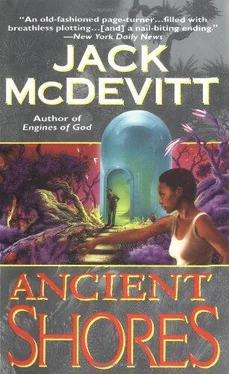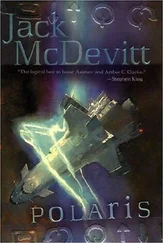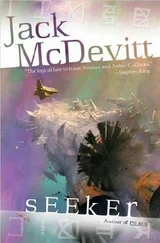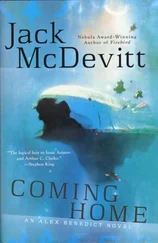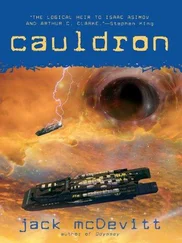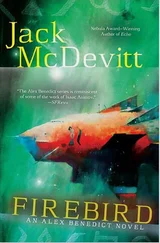The light was gray and bleak. Just enough to see by.
“This is it,” she said. “Main stage.”
It was empty. A few columns reached up to connect with a network of overhead beams. And that was all. A trench ran from the middle of the floor toward the other side of the dome, which would have been the front.
The door slid down.
He felt a momentary twinge until he saw a plate identical to the ones outside.
“That’s our channel,” said April, indicating the trench. “Boat came in through the front, tied up right here.” There were even a few posts that would have served the purpose.
It was getting hard to breathe. “Heads up,” Max said. “The air’s bad.” How could it have been otherwise?
They propped the doors open and used a couple of blowers to circulate fresh air inside. When they felt it was safe, they opened it up for their people and for the journalists.
The trench was about fifteen feet deep. The dimensions were sufficient to accommodate the boat. They’d have had to fold the mainmast over to get it inside. But it would have worked.
Four rooms opened off the passageway. Two might once have been apartments or storage areas but were now simply bare spaces. The others contained cabinets and plumbing. The cabinets were empty. A sunken tub and a drainage unit not unlike the device on the ketch suggested one had been a washroom. The other appeared to be a kitchen.
Max noticed almost immediately a sense of anticlimax and disappointment. April especially seemed down. “What did we expect?” he asked.
It was just empty .
No interstellar cruiser. No ancient records. No prehistoric computers. No gadgets.
Nothing.
The true power centers are not in the earth. But in ourselves.
—Walter Asquith,
Ancient Shores
Tom Brokaw displays just the right amount of skepticism. “There is,” he says, “more evidence tonight that extraterrestrials may have visited North America near the end of the last ice age. Scientists today entered a mysterious structure that may have been buried for thousands of years on a ridge near the Canadian border.” A computer graphic of the Walhalla—Fort Moxie area appears beside him, and the camera cuts quickly to overhead shots and silhouettes of the Roundhouse. “This building is constructed of materials that, we are being told, cannot be reproduced by human technology. Robert Bazell is on the scene.”
Bazell is standing in front of the Roundhouse, and he looks cold. The wind tries to take the microphone out of his hand. “Hello, Tom,” he says, half turning so the camera can get a better look at the structure. “This is the artifact that scientists think may have been left by someone ten thousand years ago. No one knows where it came from or who put it here. It is constructed of a material that experts say we’ve never seen before. A team led by Dr. April Cannon got inside today for the first time, and this is what they saw.”
The interior of the dome rises above the viewer. Accompanied by strains from Bach’s Third Concerto for Organ, the camera glides along the green curves and over the gaping trench.
To Max, watching with April and the Laskers at the Prairie Schooner, it only stirred his sense of disappointment and bad luck. Even the cabinets had been empty! At the very least, Max thought, it would have been nice to find, say, a discarded shoe.
Something.
“If the Roundhouse is really as old as some of the experts are saying, Tom,” Bazell continues, “we are looking at a technological marvel. The temperature inside is almost sixty degrees. As you can see, it’s cold up here. So we have to conclude that there’s a heating system and that it still works.” They cut back to the top of the ridge, where snow is blowing and people are standing around with their collars tugged up. “I should add that the structure glows in the dark. Or at least it did last night. So much so that it frightened people in nearby Walhalla and emptied the town.”
Split screen. Brokaw looks intrigued. “Are we sure it’s not a hoax?”
“It depends on what you’re asking about, Tom. The experts don’t all agree on the age of the Roundhouse. But they seem to be unanimous that the material it’s made from could not be produced by any human agency.”
They cut to a bearded, older man seated at a desk before a book-lined wall. The screen identifies him as Eliot Rearden, chairman of the Department of Chemistry, University of Minnesota.
“Professor Rearden,” says Brokaw, “can you hear me?”
“Yes, Tom.”
“Professor, what do you make of all this?”
“The claim appears to be valid.” Rearden’s gray eyes blaze with excitement.
“Why do you say ‘appears,’ Professor?”
He thinks it over. “I wouldn’t want to imply there’s any problem with the evidence itself,” he says. “But the implications are of a nature that causes one to hesitate.”
Brokaw asks quietly, “What are the implications?”
Rearden gazes directly into the camera. “I think if we accept the results of the analyses, we are forced to one of two conclusions. Either there were people living here at the end of the last ice age who were technologically more advanced than we are and who somehow managed to get lost, or—” He looks directly out of the screen. “Or we have had visitors.”
“You mean UFOs, Professor. Aliens.”
Rearden shifts uncomfortably. “If there is a third possibility, I don’t know what it might be.” He purses his lips. “We are faced here with an imponderable. I think it would be a good idea to keep our minds open and not jump to any conclusions.”
The illuminated image of the Roundhouse under a bright moon appears onscreen. It is a live aerial shot. “Now that scientists are inside,” says Brokaw, “hard answers should come quickly. NBC will be doing a special on the Johnson’s Ridge enigma tonight on Special Edition at nine.”
Tom Lasker speared a piece of steak and pointed it at the screen. “I’m glad to hear we’re on the verge of hard answers,” he said.
In the morning, April and Max arrived on Johnson’s Ridge at dawn, just in time to watch the green aura fade. A helicopter circled overhead. Press vehicles pulled onto the access road behind them.
Their fax machine had run out of paper during the night, and several thousand e-mail messages had piled up. Everyone on the planet was asking to tour the Roundhouse. “We’ll have to work something out,” April said. “But I don’t know how we’re going to do this. We aren’t going to be able to accommodate all these people.”
Journalists and VIPs were already arriving in substantial numbers. April talked to the media for a while. She described her fears that the results of her investigations would cause her to be written off by her scientific colleagues. “That hasn’t happened,” she added. “Everyone’s being very open-minded about this.” She explained the need to protect the premises from hordes of visitors until they could glean whatever information the Roundhouse might contain. “Therefore,” she said, “we’ll allow six pool reporters inside. Three TV, three print. You folks decide. Give me thirty minutes to set it up. Those who do go in will be asked to stay with the guide. Anybody who wanders off gets the boot. Agreed?”
Some grumbled, most laughed. While they tried to sort out their representatives, she and Max walked around to the stag door. It had been braced open all night with a spade while exchangers ventilated the interior. April took the spade away, and the door closed. She removed her own glove and pressed her fingers against the stag’s head. As Max expected, nothing happened.
“So we have established,” she said, “that it is George’s glove, yes?”
Читать дальше
